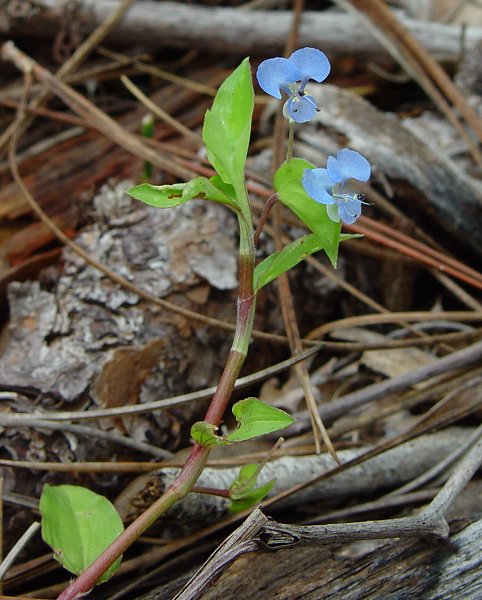Commelina diffusa Burm. f.
Dayflower

Native
CC = *
CW = -3
MOC = 51
© DETenaglia
Commelina diffusa Burm. f.Dayflower | |
 |
Native CC = * CW = -3 MOC = 51 |
© DETenaglia |
|
Family - Commelinaceae Habit - Annual forb with slender, fibrous roots. Stems - Decumbent to ascending, to 80 cm, often rooting at nodes.
Leaves - Alternate, simple, entire. Blades 2.5-8.0 cm long, lanceolate, glabrous to minutely scabrous. Base of blade forming a sheath around stem. Leaf sheaths mostly 0.5-1.0 cm long, ciliate with white hairs near the tips.
Inflorescence - Inflorescences axillary, mostly stalked, the flowers emerging from folded bract (spathe). Spathelike bracts 10-40 mm long, the margins free to the base, the lower edge (midrib of the bract) noticeably arched.
Flowers - Sepals 3-4 mm long. Petals 3, strongly unequal, the upper 2 petals 7-10 mm long, blue, the lower petal 3-5 mm long, blue. Two of the 3 staminodes with well-developed false anthers, these 4-6-lobed, yellow, lacking a reddish brown spot in the middle.
Fruits - Capsules 4.0-6.3 mm long, mostly 3-locular and 5-seeded. Seeds 2-3 mm long, the surface with a strongly developed pattern of reticulate, polygonal ridges.
Flowering - July - October. Habitat - Banks of ponds and streams, forest openings, lawns, moist sandy soils. Origin - Native to the Americas and in the Old World Tropics. Lookalikes - Other members of the genus. Other info. - This little species, the smallest-flowered of the Missouri dayflowers, occurs in scattered locations across most of Missouri. Its U.S. range is mostly in the southeastern quadrant. The plant is easy to ID in the field from its flowers, which are small, with three blue petals. It has the smallest flowers of any of Missouri's dayflowers. Another species, C. virginiana, also has three blue petals, but the flowers and the plant are both much larger. In addition, that species has spathelike bracts which are basally fused, whereas in C. diffusa the bracts are free to the base. This plant, and others in the genus, can be cooked and eaten. Photographs taken in Daytona Beach, Fl., 7-2-02 (DETenaglia); also near Gray Summit, Franklin County, MO, 9-11-2018; and at Duck Creek Conservation Area, 8-20-2024 (SRTurner). |